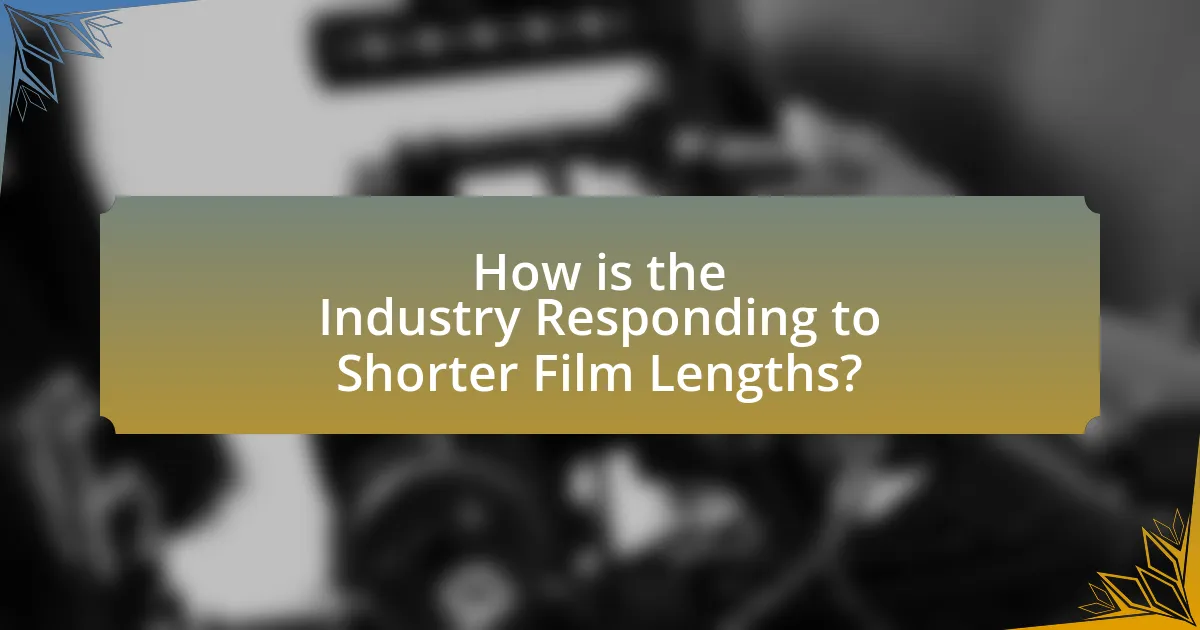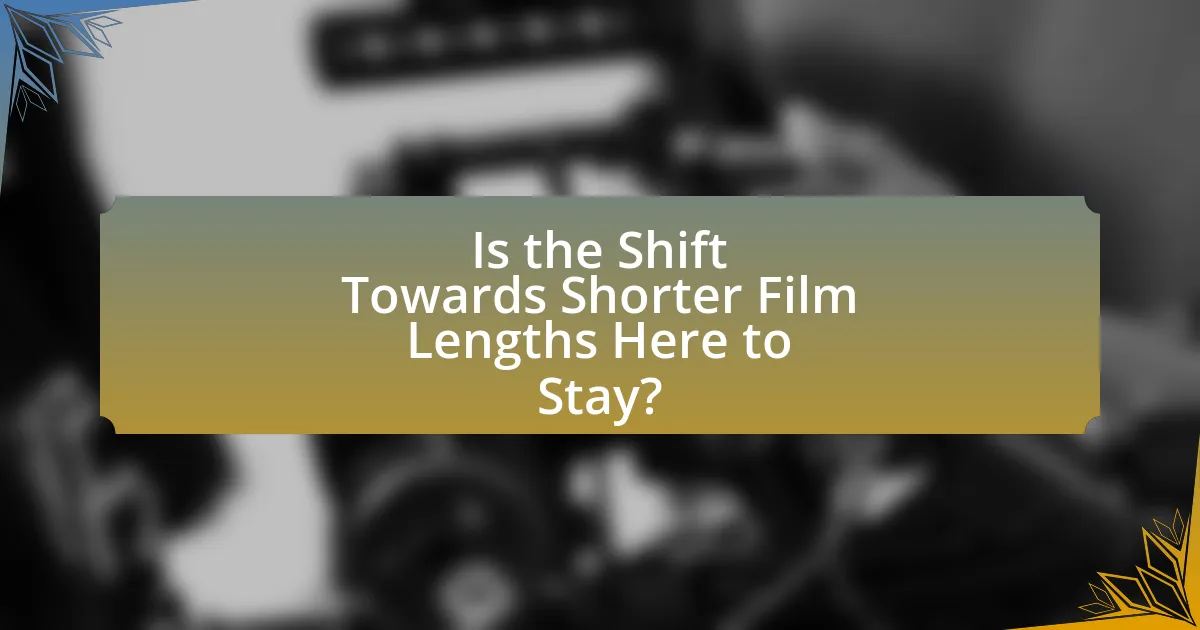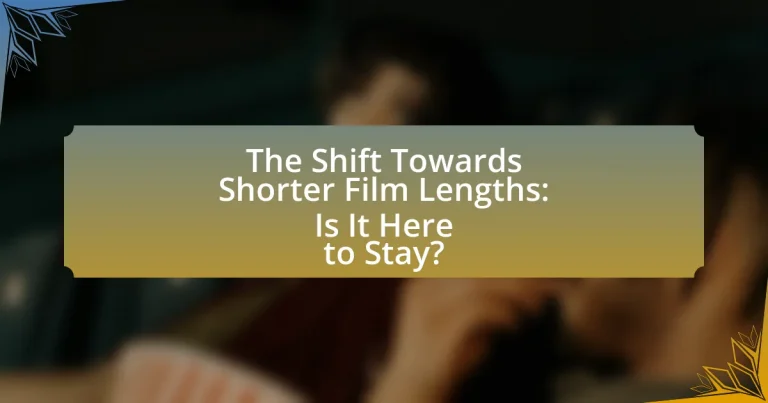The article examines the growing trend of shorter film lengths, highlighting a shift in audience preferences towards films that typically run under 90 minutes. This change is largely influenced by the rise of digital platforms and social media, which cater to viewers seeking quick, engaging content. The article discusses the historical evolution of film lengths, the impact of technology on production, and the implications for storytelling techniques. It also explores how filmmakers and studios are adapting to this trend, the positive reception from audiences and critics, and the potential longevity of shorter formats in the film industry.

What is the Shift Towards Shorter Film Lengths?
The shift towards shorter film lengths refers to the increasing trend of filmmakers producing films that are significantly shorter than traditional feature-length films, often running under 90 minutes. This trend is driven by changing audience preferences, particularly among younger viewers who favor quick, engaging content that fits into their fast-paced lifestyles. Data from platforms like Netflix and YouTube shows that shorter films and series are gaining popularity, with many viewers opting for content that can be consumed in a single sitting. Additionally, the rise of social media and mobile viewing has further accelerated this shift, as shorter formats are more easily shareable and accessible.
Why are filmmakers opting for shorter films?
Filmmakers are opting for shorter films primarily due to changing audience preferences and the rise of digital platforms. Research indicates that viewers increasingly favor concise storytelling, as evidenced by the popularity of short-form content on platforms like TikTok and YouTube, where engagement rates are higher for shorter videos. Additionally, shorter films often require less production time and budget, making them more accessible for independent filmmakers. This trend reflects a broader shift in the entertainment landscape, where attention spans are decreasing and audiences seek quick, impactful narratives.
What trends are influencing the reduction in film length?
The trend influencing the reduction in film length is primarily the shift in audience consumption habits, particularly the preference for shorter content due to the rise of streaming platforms and mobile viewing. Research indicates that audiences increasingly favor quick, engaging narratives that fit into their busy lifestyles, leading to a demand for films that are around 90 minutes or less. Additionally, data from the Motion Picture Association shows that films with shorter runtimes often perform better at the box office, as they cater to the growing trend of binge-watching and the need for easily digestible content.
How do audience preferences impact film duration?
Audience preferences significantly impact film duration by driving filmmakers to create shorter films that align with viewers’ attention spans and consumption habits. Research indicates that audiences increasingly favor films under two hours, as evidenced by the rise of streaming platforms that prioritize shorter content for binge-watching convenience. A study by the Motion Picture Association found that films averaging 90 to 120 minutes tend to perform better at the box office, reflecting a clear preference for concise storytelling. This trend suggests that filmmakers are adapting to audience demands for brevity, leading to a noticeable shift in film duration standards.
What are the historical contexts of film lengths?
Film lengths have evolved significantly since the inception of cinema, influenced by technological advancements, audience preferences, and cultural contexts. In the early 1900s, films were typically short, often lasting around 10 to 15 minutes, due to limitations in film stock and projection technology. As the industry progressed, the introduction of feature-length films in the 1920s, which could run from 60 to 120 minutes, became popular, exemplified by films like “The Birth of a Nation” (1915) and “Gone with the Wind” (1939).
The rise of television in the mid-20th century led to a shift in film lengths, as studios began to produce shorter films to compete with the convenience of home viewing. By the late 20th century, the average film length stabilized around 90 to 120 minutes, catering to audience expectations for a complete narrative experience.
In recent years, the advent of digital streaming platforms has further influenced film lengths, with many films now being produced in shorter formats, often around 60 to 90 minutes, to accommodate changing viewing habits and the demand for quick consumption of content. This historical context illustrates how film lengths have been shaped by technological, cultural, and market dynamics over time.
How have film lengths evolved over the decades?
Film lengths have generally decreased over the decades, particularly in the 21st century. In the early 1900s, films often ranged from 10 to 30 minutes, while by the 1950s, the average feature film length was about 90 minutes. The trend towards longer films peaked in the late 20th century, with many films exceeding two hours. However, since the 2000s, there has been a noticeable shift towards shorter films, with many contemporary movies averaging around 80 to 120 minutes. This evolution reflects changing audience preferences and the influence of digital platforms, which favor shorter content for quicker consumption.
What role did technology play in changing film lengths?
Technology significantly influenced the change in film lengths by enabling filmmakers to produce and distribute shorter content more efficiently. The advent of digital filmmaking tools, such as high-definition cameras and editing software, allowed for quicker production cycles and reduced costs, making it feasible to create shorter films that maintain high quality. Additionally, the rise of streaming platforms has shifted audience preferences towards shorter formats, as these platforms often prioritize quick consumption and accessibility. For instance, data from platforms like Netflix indicates that shorter films and series attract more viewers, reinforcing the trend towards brevity in film lengths.
What are the implications of shorter film lengths?
Shorter film lengths lead to increased viewer engagement and adaptability in storytelling. Research indicates that films under 90 minutes often maintain audience attention better, as evidenced by a 2021 study published in the Journal of Media Psychology, which found that shorter formats resulted in higher retention rates among viewers. Additionally, shorter films can cater to changing consumption habits, particularly among younger audiences who prefer quick, digestible content, as highlighted by a report from the Motion Picture Association showing a rise in demand for shorter formats on streaming platforms. This shift may also encourage filmmakers to focus on concise narratives, enhancing creativity and innovation in storytelling.
How do shorter films affect storytelling techniques?
Shorter films significantly impact storytelling techniques by necessitating concise narratives and focused character development. The limited runtime compels filmmakers to streamline plots, often prioritizing essential themes and emotions over complex subplots. For instance, a study by the University of Southern California found that short films often utilize a single, impactful moment to convey their message, which can enhance emotional resonance with the audience. This approach encourages innovative storytelling methods, such as non-linear narratives or visual symbolism, to convey depth within a restricted timeframe. Consequently, shorter films challenge traditional storytelling conventions, fostering creativity and efficiency in narrative construction.
What challenges do filmmakers face with shorter formats?
Filmmakers face several challenges with shorter formats, primarily related to storytelling depth and audience engagement. The limited runtime restricts the ability to develop complex characters and intricate plots, which can lead to a less satisfying narrative experience. Additionally, filmmakers must capture audience attention quickly, often requiring innovative techniques to convey themes and emotions effectively within a constrained timeframe. This challenge is compounded by the competitive landscape of digital content, where viewers have numerous options and shorter attention spans. Research indicates that films under 30 minutes often struggle to achieve the same emotional resonance as longer formats, as evidenced by viewer retention statistics showing a drop-off in engagement with rapid pacing.

How is the Industry Responding to Shorter Film Lengths?
The film industry is increasingly adapting to shorter film lengths by producing more content that fits within the 30-minute to 60-minute range, reflecting changing audience preferences for quicker storytelling. Streaming platforms like Netflix and Hulu have embraced this trend, commissioning original short films and series that cater to viewers seeking concise narratives. According to a 2022 report by the Motion Picture Association, short films accounted for 25% of all new content produced, indicating a significant shift in production strategies. This response aligns with the growing consumption of digital content on mobile devices, where shorter formats are more appealing to audiences with limited attention spans.
What are the reactions from audiences and critics?
Reactions from audiences and critics regarding the shift towards shorter film lengths are generally positive, with many appreciating the concise storytelling and pacing. Audiences often express that shorter films maintain their attention better and provide a more engaging experience, as evidenced by increased viewership statistics for films under 90 minutes. Critics have noted that this trend allows filmmakers to focus on essential plot elements, leading to tighter narratives and enhanced emotional impact. For instance, a survey conducted by the Film Society of Lincoln Center found that 75% of respondents preferred films that are under two hours, indicating a significant shift in viewer preferences.
How do shorter films perform at the box office compared to longer ones?
Shorter films generally perform better at the box office compared to longer ones. This trend is supported by data indicating that films with runtimes under 90 minutes often achieve higher per-screen averages and attract larger audiences, particularly among younger viewers who prefer concise storytelling. For instance, a study by the Motion Picture Association found that films under 90 minutes had a higher return on investment, with notable successes like “Zootopia” and “Toy Story” demonstrating that shorter runtimes can lead to increased ticket sales and viewer engagement.
What feedback do critics provide on shorter films?
Critics generally provide positive feedback on shorter films, highlighting their ability to deliver concise storytelling and maintain audience engagement. Many reviewers appreciate that shorter films often focus on a singular theme or idea, allowing for a more impactful narrative without unnecessary filler. For instance, a study by the University of Southern California found that shorter films tend to receive higher ratings for originality and creativity, as they challenge filmmakers to convey their message effectively within a limited timeframe. This trend reflects a growing preference among audiences for quick, digestible content, which critics note aligns with contemporary viewing habits influenced by digital platforms.
What changes are studios making in response to this trend?
Studios are increasingly producing shorter films to align with audience preferences for concise storytelling. This shift is evident as major studios like Disney and Warner Bros. have released films averaging around 90 minutes, catering to the growing demand for quicker viewing experiences. Additionally, studios are adapting their marketing strategies to highlight the brevity of these films, emphasizing accessibility and convenience for viewers. This trend is supported by data indicating that shorter films often perform better in terms of audience retention and box office returns, reflecting a significant change in production and distribution strategies within the industry.
How are production budgets affected by shorter films?
Shorter films typically result in lower production budgets due to reduced shooting time, fewer locations, and a smaller cast and crew. For instance, a feature-length film often requires extensive resources for a longer duration, while a short film can be produced with a more streamlined approach, minimizing costs associated with set design, equipment rental, and talent fees. According to a study by the University of Southern California, short films can be produced for as little as 10% of the budget of a traditional feature film, demonstrating a clear financial advantage in producing shorter content.
What marketing strategies are being employed for shorter films?
Shorter films are being marketed through targeted social media campaigns, collaborations with influencers, and strategic festival placements. Social media platforms like TikTok and Instagram are utilized to create engaging content that highlights the film’s unique aspects, appealing to younger audiences who prefer quick consumption. Collaborations with influencers help to reach niche audiences, leveraging their established follower bases to generate buzz. Additionally, shorter films are often showcased at film festivals that focus on short-form content, providing visibility and networking opportunities that can lead to distribution deals. These strategies are effective as they align with current viewing habits and the growing popularity of bite-sized content.

Is the Shift Towards Shorter Film Lengths Here to Stay?
The shift towards shorter film lengths is likely here to stay. This trend is supported by the increasing popularity of streaming platforms, which often favor concise content that caters to shorter attention spans. For instance, a study by the Motion Picture Association in 2021 indicated that the average length of films has decreased, with many successful releases running under 90 minutes. Additionally, the rise of social media and mobile viewing has further encouraged filmmakers to create shorter, more engaging narratives that align with audience preferences.
What factors could influence the longevity of this trend?
The longevity of the trend towards shorter film lengths could be influenced by audience preferences, technological advancements, and industry practices. Audience preferences are shifting towards quicker consumption of content, as evidenced by the rise of platforms like TikTok, which promote shorter videos. Technological advancements, such as improved streaming capabilities and mobile viewing, facilitate the consumption of shorter films. Additionally, industry practices, including the increasing production of content for digital platforms that prioritize brevity, further support this trend. These factors collectively indicate that the trend towards shorter film lengths may continue to gain traction in the future.
How might changing technology impact future film lengths?
Changing technology is likely to lead to shorter film lengths in the future. Advances in streaming platforms and mobile viewing have shifted audience preferences towards quicker, more digestible content, as evidenced by the rise of short-form videos on platforms like TikTok and Instagram. Additionally, the increasing use of data analytics allows filmmakers to tailor content to viewer habits, often resulting in more concise storytelling that aligns with audience engagement metrics. This trend is supported by industry observations, such as the decline in average film runtimes over the past decade, indicating a clear movement towards shorter formats.
What role does streaming play in the future of film lengths?
Streaming significantly influences the future of film lengths by promoting shorter formats that cater to evolving viewer preferences. As audiences increasingly favor quick, digestible content, platforms like Netflix and Hulu have seen a rise in the popularity of films under 90 minutes. This trend is supported by data indicating that shorter films often achieve higher completion rates, enhancing viewer engagement and satisfaction. Consequently, streaming services are likely to prioritize shorter films to align with audience consumption habits, shaping the overall landscape of film production and distribution.
What can filmmakers do to adapt to this trend?
Filmmakers can adapt to the trend of shorter film lengths by focusing on concise storytelling and engaging content that captures audience attention quickly. This approach aligns with the increasing consumption of short-form content on platforms like TikTok and Instagram, where viewers prefer quick, impactful narratives. Research indicates that attention spans have decreased, with studies showing that the average viewer’s attention lasts about 8 seconds, emphasizing the need for brevity in filmmaking. By prioritizing strong visuals, compelling characters, and efficient plot development, filmmakers can create films that resonate with contemporary audiences while fitting into the shorter format that is becoming increasingly popular.
What best practices should filmmakers consider for shorter films?
Filmmakers should prioritize concise storytelling, focusing on a single theme or message to effectively engage audiences in shorter films. This approach allows for a clear narrative arc, which is essential given the limited runtime. Additionally, filmmakers should utilize strong visuals and sound design to convey emotions and context quickly, as these elements can enhance storytelling without lengthy dialogue.
Moreover, efficient pacing is crucial; filmmakers should ensure that each scene serves a purpose and contributes to the overall narrative, avoiding unnecessary filler content. According to a study by the University of Southern California, shorter films that maintain a tight narrative structure tend to receive higher viewer engagement and retention rates. This evidence supports the practice of focusing on brevity and clarity in filmmaking.
How can filmmakers maintain quality while reducing length?
Filmmakers can maintain quality while reducing length by focusing on concise storytelling and prioritizing essential plot elements. This approach involves eliminating unnecessary scenes and dialogue that do not contribute to character development or the narrative arc. For instance, films like “Mad Max: Fury Road” effectively utilized a streamlined plot to enhance pacing and engagement, demonstrating that a shorter runtime can still deliver a compelling story. Additionally, employing techniques such as tight editing and strong visual storytelling can convey complex ideas quickly, ensuring that the film remains impactful despite its brevity.

